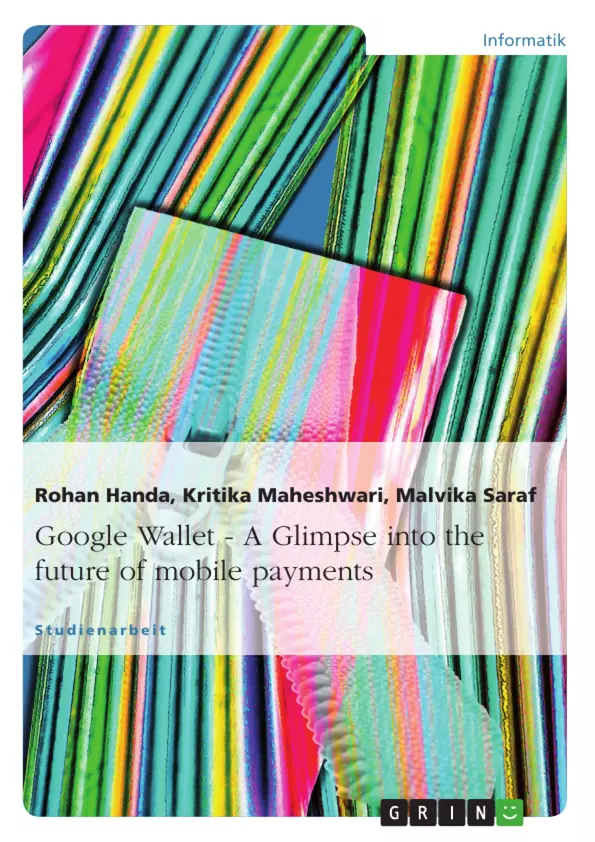Over the past few thousand years of evolution, the way we pay has changed shapes and materials. It has gone from gold to coins, paper money to plastic cards and now with Google’s venture into the mobile payment industry, we are at the threshold of the next big shift.
Google Wallet is a mobile payment Android app that transforms a phone into a wallet. This app utilizes the Near Field Communication (NFC) technology that allows its users to pay for purchased items and redeem offers. At this initial stage of business, there are many features and factors that Google needs to change in order to bring about the mass adoption of this service.
As the Business Technology Analysts at Google, we - Kritika Maheshwari, Malvika Saraf and Rohan Handa aim at addressing the hurdles for this technology and the methods to bring it to fruition. In the process we evaluate Google’s profit motivation and the bigger strategy behind this service. First, we explain the business approach which describes the importance of the adopted business model. We use Porter’s Five Force analysis to determine the competitive intensity in the market followed by SWOT analysis to give recommendations that will help in the mass adoption. Finally, we focus our paper on formulating a strategy canvas in order to study the existing payment methods in comparison to our service. The paper concludes with recommendations to Google for promoting wide customer acceptance.
Table of Contents
- Executive Summary
- Introduction
- Business Model
- Business Approach
- Stakeholders
- Target Customers
- Buyers of Google Wallet
- Revenue Sources
- SWOT Analysis
- Strengths
- Weaknesses
- Opportunities
- Threats
- Strategic Analysis: SWOT
- Porter's Five Force Analysis
- Existing Rivalry
- Bargaining Power of Buyers
- Bargaining Power of Suppliers
- Barriers to Entry
- Threat of Substitutes
- Key Points: Porter's Analysis
- Strategy Canvas
- Convenience of making online and offline transactions
- Convenience of mobility
- Personalization and Location
- Security
- Recommendations
Objectives and Key Themes
The main objective of this paper is to analyze Google Wallet, a mobile payment Android application, and address the hurdles to its mass adoption. The authors aim to evaluate Google's profit motivation and overall strategy behind this service, using Porter's Five Forces and SWOT analysis to provide recommendations for wider customer acceptance.
- Analysis of Google Wallet's business model and approach.
- Evaluation of the competitive landscape using Porter's Five Forces.
- Assessment of Google Wallet's strengths, weaknesses, opportunities, and threats (SWOT).
- Development of a strategy canvas to compare Google Wallet with existing payment methods.
- Recommendations for promoting wider customer acceptance of Google Wallet.
Chapter Summaries
The Executive Summary introduces Google Wallet and its potential to revolutionize mobile payments, highlighting the need to overcome obstacles for mass adoption. The Introduction positions Google Wallet as an innovative solution aiming for simplicity and efficiency in online and offline transactions. The Business Model section details the collaborative business approach, emphasizing partnerships with banks, credit card companies, and telecommunication firms to leverage their customer bases. The SWOT Analysis section will likely delve into the internal and external factors affecting Google Wallet's success. The Porter's Five Forces Analysis section will examine the competitive intensity within the mobile payment market.
Keywords
Google Wallet, mobile payments, NFC technology, business model, collaborative approach, Porter's Five Forces, SWOT analysis, strategy canvas, market adoption, competitive landscape.
- Quote paper
- Rohan Handa (Author), Kritika Maheshwari (Author), Malvika Saraf (Author), 2011, Google Wallet - A Glimpse into the future of mobile payments, Munich, GRIN Verlag, https://www.hausarbeiten.de/document/183132


